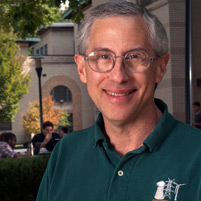Optimizing Renewable Energy

Jay Apt
In well over half of the United States, legislatures have required that an increasing percentage of electric power be generated by renewables — like solar and wind power.
The legislation has been supported by a coalition of three parties: environmentalists who want to reduce greenhouse gas and other pollution, advocates of green jobs, and energy independence groups.
Carnegie Mellon University professor Jay Apt has developed an extensive body of work demonstrating that it matters how renewable resources are integrated into the U.S. electricity grid.
Apt and the researchers at CMU's Tepper School of Business and Carnegie Mellon Electricity Industry Center (CEIC) are on the leading edge of quantifying how to use new technologies to the best advantage when integrating large-scale renewable electricity.
Apt's work has three focuses: markets for electric power, security and reliability of the electric power system and low carbon dioxide generation, including renewable power.
"In renewables and other low carbon electric power, we have done a lot of work in the basic mathematics of wind power and of solar power that's shown how you can best integrate those into the existing electric power system at the lowest cost," Apt said.
Renewables, including wind and solar, are variable and intermittent sources. Nonetheless, the electricity grid must provide reliable electricity on demand, 24 hours a day.
Recently, Apt and his colleagues published a summary of their research over the past five years pertaining to this important issue titled, "Smart Integration of Variable and Intermittent Renewables," that clearly demonstrates the value of a quantitative approach to analyzing integration.
For instance, wind-generated electricity presents variability on every time scale from seconds to days, and this variability must somehow be accommodated as wind is incorporated into the electric grid.
Limited quantities of wind power can be successfully integrated by using the current generation and demand-side response mix, but as deployment of this variable resource increases, the resulting variability will be a bit more costly to mitigate.
Apt is one of more than 100 faculty and researchers across the university working together to solve the world's toughest energy challenges through the Wilton E. Scott Institute for Energy Innovation.
The Scott Institute seamlessly combines CMU's longstanding expertise in technology, policy, integrated systems and behavioral and social science.
Related Links: WSJ Article: Blackouts Are a Fact of Life | Jay Apt Presentation: Electricity in the 21st Century | Scott Institute for Energy Innovation | Engineering and Public Policy | Tepper School of Business
